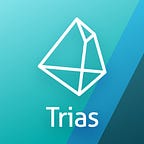Academic Exchange | Trias Jointly Hold a Salon with School of Software and Microelectronics, PKU
On Nov. 5th, a salon activity with the theme of ‘Trias Consensus Technology Discussion’ jointly be held by PKUSSM-OCTA Innovation Laboratory. Trias CEO Dr. Ruan Anbang , Trias CTO Dr. Wei Ming and Professor Shen Qingni of Peking University, as well as many doctoral students in the laboratory, all of whom discussed the Trias project landing process and further exchanged technical details of innovation development.
At present, the various consensus mechanism, such as PoW, PoS, DPoS, is familiar to us. But there are some shortcomings cannot be overlooked. Based on trusted computing of Heterogeneous Trusted Execution Environment (TEE) and small-world network graph computing technology of Heterogeneous Consensus Graph Algorithm (HCGrahp), Trias can virtually accelerate consensus.
At the meeting, Ruan Anbang first introduced the project landing status quo. He mentioned that Trias is currently negotiating cooperation in the realm of agriculture, industry, government affair, energy, and health care, and has already reached cooperation with some of the outstanding projects, such as the ASEAN Marine Economic Research Institute and so on. All above achievements in promotion of thousands of enterprises on the chain and cloud, as a result, it has taken a giant step. At present, many companies unwilling to put confidential data on the cloud, because it cannot remove the risk of data validation. If uploaded data to the cloud, how do you know whether someone is secretly reading and profiting from it? In the internet world, once data is handed over to others, it seems to lose control of the data, which is very unfair to the data producers.
This problem can be solved by blockchain. Ruan Anbang believes that the blockchain in authentic rights mainly through the data ledger to achieve. Data ledger, in short, uses blockchain to record all processes of data usage and record data access. Accordingly, he put forward a concept called ‘Data Mine’. Through the blockchain, data producers mine and record the value of all data, and obtain a certain amount of income. In addition, it was mentioned during the discussion that since commodities such as vaccines and seafood had clear requirements for temperature in terms of storage and transportation, therefore, the data unchangeable through blockchain is meaningful at that time. Professor Shen Qingni also pointed out that in the face of these industry pain points, we can solve more practical problems in a way of modeling.
Then, Trias CTO Wei Ming focus on its project to make a presentation, in particular the Ethereum project gains or losses. As we all know, Ethereum, as the recognized blockchain 2.0 version, has more heat in the community than other public chains. However, it has also experienced the dilemma of being attacked by hackers because of the fork, as a result, the Ethereum classic is came out. We know that last year, led by BAT (Baidu, Alibaba, Tencent), the internet companies have poured into blockchain industry, but a year later, these projects have a mediocre response in foreign countries, why? To this, Wei Ming shares his own opinion. Blockchain is essentially a peer-to-peer distributed ledger database, which provides a decentralized and trust-free paradigm. In the blockchain system, every unrelated network user need not to establish trust between each other, but transactions can be completed by blockchain protocol systems. That is to say, without centralized party control or trusted individual foundation, blockchain technology can reach consensus mechanism on legality of transaction.
After analyzing the current situation, the topic goes back to the Trias project itself. Trias network is different from other public chains. If you want to be an Ethernet node, simply download an agent consensus. But Trias nodes are huge difference, the working environment must have a TEE foundation, such as SGX, TrustZone, TXT. In addition, you must put their message broadcast over the entire network. After joining Trias network, Trias will pass through a certain period sky ladder, the highest ranked node will be selected as the super node in order.
The salon talks were very warm, and the students of Peking University also joined in the discussion in one after another. Someone asked questions, such as if super nodes are determined through integra, they will have an advantage over the nodes that come first, how can we ensure that the subsequent nodes have sufficient power? After selecting the super node, will it be no change? Dr. Wei Ming answered one by one.
At the end of the meeting, everyone was still interested, but due to time constraints, many problems had to be left next time.
